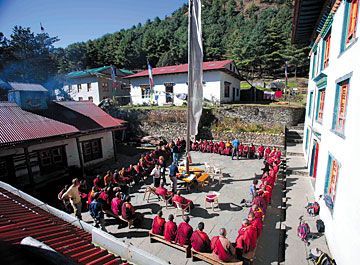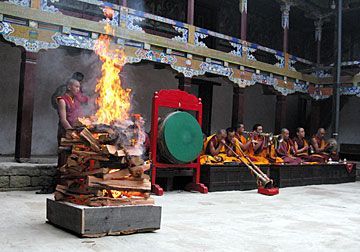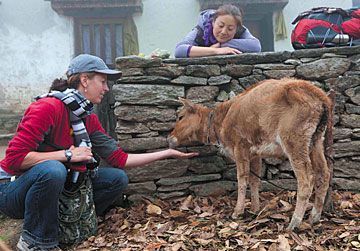Whether you accept it, avoid it or live somewhere in between, insurance coverage has become a defining issue for our profession. Patients increasingly expect to use their benefits, practitioners want to be compensated fairly for their time and expertise, and the system itself remains – at best – fragmented. The encouraging news is that coverage has expanded in meaningful ways. The challenging news is that reimbursement, across the board, remains inadequate.
Nomads with Needles: Part II
In the fall of 2011, 16 acupuncturists from USA and Canada joined a "World Healing Exchange (WHE)" tour organized by Acupuncturists Without Borders (AWB). This was the third outreach activity to Nepal and an essential step in nurturing the connection between Nepalese Acupuncturists and AWB. We would like to share reflections and photos from our group to help paint a picture of how community based acupuncture treatments are helping people recover from trauma in urban and rural Nepal.
Collaboration and training
Diana Fried, executive director of Acupuncturists Without Borders said she became more committed to doing more for the people in Nepal after a trip she took in 2009.
"I began to understand more deeply the fragile peace process in Nepal and the tremendous trauma that existed among these kind and gentle people who had experienced conflict for decades, including kidnappings, torture, extortion and human trafficking of children," said Fried who led a team of trainers in 2010 to support Nepali acupuncturists and other health care practitioners expand their skills using the NADA protocol, sound healing and protocols for mobile clinics to use in case of a disaster.

Fried said they trained 70 people and that on the recent WHE in Oct/Nov of 2011 the Nepalese trainees raved beyond imagination about the results they were having using seeds and needles with the NADA protocol.
"They called it a 'miracle' and they have treated over 10,000 people since we trained them," said Fried.
Fried noted that after the visit, Dr Hira and Dr Khrishna were holding regular weekly health camps, sometimes they have 500 people lined up waiting and in addition, they have created their own not-for-profit organization called Care for Humanity (Nepal).
"I went to one of the camps, where men and women lined up sitting on the floor of a monastery, waiting for treatment. As we spoke with each of them, I heard stories of many ways they had experienced physical recovery from treatments (addiction, hypertension, trauma and stress). I also saw and felt the inexplicable power of this community healing, for people living in financial poverty (though not spiritual poverty) and with minimal access to health care. The gift of service was being passed on in multiple ways, including coming back to me as I witnessed this event. This was the highlight of my trip," said Fried.
Clinics in Kathmandu
AWB collaborated with local secular not-for-profit organizations, to organize clinics in urban Kathmandu. Recently, the Nepalese people have created local not-for-profit societies to help support the peace movement; women traumatized by war or prostitution; or orphanages for children who have been trafficked. Their mutual goal is for Nepalese people to gradually become more independent and support their own charitable endeavours. An outstanding example was the Umbrella Foundation. Our clinics with the children were an amazing highlight for trip participants, all acupuncturists from the U.S. and Canada. We modified the NADA protocol by using 2-3 needles or seeds on each ear. The orphanage was organized into five homes for 25 boys or girls, with a married couple as "house parents" to guide each family of orphans. Here are some reflections from the participants who visited:

"Visiting the Umbrella Foundation was the highlight of my trip. We gave acupuncture to a group of orphan girls...some were very giddy with laughter and others quite solemn, but once we got the needles and seeds in there was a quiet "hush" and a sense of calm that overcame the room...some of the girls didn't want needles, but with a bit of encouragement and smiles, I was able to convince them to try at least 2 in each ear. After the treatment, they were all so happy...they were coming up to us and saying, "Thank you sisters." I will never forget that experience."(Noel Wright, MS Ac., Acupuncture Physical Medicine, Toronto, Canada)
"The most magical afternoon for me was at the Umbrella Foundation where a trained by AWB Nepali acupuncturist and I treated a room of 28 boys, seated on mats in a small sunlit room, ages ranging from 12-16 ... they were so sweet and open to the work." (Sarah Tae, L.Ac., Berkeley, Calif.)
"Most of them, even the younger ones of age 7 or 8, sat in perfect meditation poses up to 45 minutes to process the needles. I was amazed to witness the depth of spiritual connection that existed in the young and the old alike...truly as the last needle went in the last ear, a wave of ease flooded the room. These are young boys full of energy and suddenly they were all gently dozing, sweetly swaying, some peeking to see what others were doing, all smiling." (Cal Millar, L.Ac., Ketchum, Idaho)
For us, some experiences were heart rending as the traumatized women were often so young. In the Saathi shelter for battered women (http://saathi.org.np/) one nervous lady was reluctant to move her sari, the reason was her severe mutilation with both ears severed. Noel's quick decisions to insert H7 instead of the NADA protocol, helped overcome her anxiety so she could relax into a healing space.
The Himalayas

We experienced many other adventures and cultural experiences: trekking among Himalayan peaks, hanging prayer flags, sleeping in a nunnery, eating Sherpa stew in a Tibetan kitchen, watching burial ceremonies and colorful traditional dances, endless waiting for flights and the bad weather to clear, a tilaka blessing from a Yogi.
Acupuncturist Amy Wehner of Colorado describes the experience:
"We had arrived in the mountains after several days of being stuck in Kathmandu due to foggy weather. The air was clean and clear. I felt so alive again to be in nature and surrounded by such beauty. ... The next day, we had a long arduous hike ahead of us to the Chiwong Monastery for the Buddhist ceremony called Mani Rimdu - a ceremony for long life, compassion and transformation.
On the way Amchi Tsering, a Tibetan Doctor, asked us to detour and first hike up to Selo Monastery in the morning to treat the monks there. At this high altitude the air was thin and crisp, it was cold although the sun shone in a blue sky. I wasn't sure if I was up for the extra effort since I didn't sleep well and was feeling tired and a bit homesick, since I had been in Nepal for over a month already. To support myself, I said the mantra "Om Mani Padme Hum," a mantra for compassion, as I walked the steep incline up to Selo Monastery. We set up the clinic in a large square for 72 monks - both old and young. We each had our own sections moving around clockwise, in Buddhist tradition. I needled many very young monks that looked a little afraid. I would show them the very thin, short needles and say "very small" and smile. They were all so brave and courageous to try acupuncture!
As I placed the needle on the ears of the monks and inserted them, I softly said "Om Mani Padme Hum" in a low voice. Some of the young monks laughed, but I could tell it made them more at ease. The monks settled in nicely to a quiet and peaceful state. I felt happy in my heart to pray and hold space. I whispered the same mantra as I pulled the needles from their ears."
Mani Rimdi Festival
"Arriving in Nepal so soon after the beloved leader Trulshig Rinpoche had passed was very special; Tsan-Tsang Rimpoche, reincarnate of Trulshig's father, was now filling the role of master of ceremonies during the Mani Rimdi festival. It was a period of mourning and transition. The festival was now a prayer vigil for the reincarnation of Trulsing Rimpoche," said Patti Fullin, L.Ac. of Kenosha, Wisconsin.

It felt very intimate for AWB to be part of this grieving ceremony alongside the monks and local Sherpa people. We camped in a Tibetan garden, walked up the hill to the Chiwong Monastery drawn by the call of the monk trumpeters on the roof. Inside the monastery courtyard we were included in the ceremonies. From inside the deity house the procession of monks emerged, dressed in maroon and ochre, sounding cymbals, bells and trumpets.
According to Thomas Kelly, our guide and world renowned photographer: "The mandala is carefully constructed, grain by grain, from coloured sand into an intricate symbolic design that takes many days to complete…During the meditation, the monks visualize all their compassion flowing in the form of the mantra into the sand mandala and rilbu (long life) pills… From the mandala the compassion radiates out, blessing all those who come to Chiwong…The Fire Puja is performed in the courtyard the next day. Most of the village people have gone home, and Chwong has a quiet, almost family atmosphere." The fire burns, symbolically allaying all the harm in the world. Then the mandala is dismantled and finally washed by the spring down to the villages below, all part of the symbolism of the transitional nature of life.
The Chiwong monks certainly cared for the spiritual needs of the local people. However, unlike monks I had seen in Tibet, Chiwong monks seemed to have minimal knowledge of Tibetan traditional medicine such as tongue and pulse diagnosis or herbal remedies. Reputedly that region of the Himalayas was famous for its rare medicinal herbs. However, the grieving Tsan-Tsang Rimpoche, took great interest in AWB's work, gave us a special audience and blessing of silk scarves. His reflective advice on how to improve our acupuncture practice, was meaningful: to approach each treatment with a spirit of compassion and incorporate the power of visualization. What a privilege for AWB to be included in this deeply spiritual experience. What great work still needs to be done to bring relevant health care to people in these isolated valleys of the great Himalayas. AWB looks forward to continued cooperation with the people of Nepal.
Acupuncturists Without Borders mission is to bring compassionate and effective relief and recovery to underserved communities affected by disaster, war, conflict and poverty around the world.


